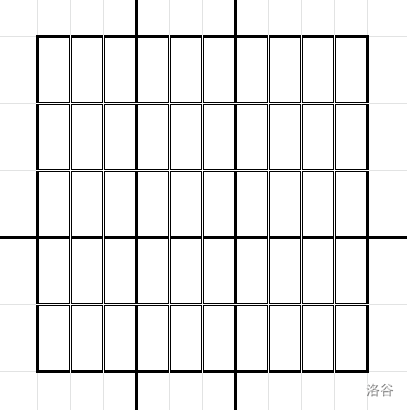CF1801F Another n-dimensional chocolate bar
题目背景
可以在 [P13527](https://www.luogu.com.cn/problem/P13527) 评测本题。
题目描述
妈妈给小男孩瓦夏买了一块 $n$ 维巧克力,这块巧克力是一个 $n$ 维立方体,每条边的长度都是 $1$。这块巧克力已经被标出了分割线。在第 $i$ 个维度上,可以用超平面将巧克力沿该维度分成 $a_i$ 份相等的小块。因此,巧克力总共被分成 $a_1 \cdot a_2 \cdot a_3 \cdot \ldots \cdot a_n$ 块,每一小块在第 $i$ 个维度上的长度都是 $\frac{1}{a_i}$,因此每一小块的体积为 $\frac{1}{a_1 a_2 \cdots a_n}$。
瓦夏和他的朋友们想要把巧克力切成至少 $k$ 块,并且希望最小的那一块的体积尽可能大。巧克力只能在原本小块的连接处切割,每一次切割都必须是沿着参与形成小块的某个超平面,且每次切割都要贯穿整个巧克力。所有切割都完成后,瓦夏才将巧克力分成小块。
更正式地说,瓦夏需要选择 $b_1, b_2, \dots, b_n$ 这 $n$ 个数($1 \le b_i \le a_i$),表示在第 $i$ 个维度上将巧克力切成 $b_i$ 份。需要满足 $b_1 \cdot b_2 \cdot \ldots \cdot b_n \ge k$,这样切割后才能得到不少于 $k$ 块巧克力。可以注意到,在最优切割方案下,最小的一块包含 $\lfloor \frac{a_1}{b_1} \rfloor \dotsm \lfloor \frac{a_n}{b_n} \rfloor$ 个小块,其体积为 $\lfloor \frac{a_1}{b_1} \rfloor \dotsm \lfloor \frac{a_n}{b_n} \rfloor \cdot \frac{1}{a_1 a_2 \cdots a_n}$。
瓦夏希望得到的答案是:最小一块体积的最大可能值乘以 $k$,也就是最大化 $\lfloor \frac{a_1}{b_1} \rfloor \dotsm \lfloor \frac{a_n}{b_n} \rfloor \cdot \frac{1}{a_1 a_2 \cdots a_n} \cdot k$。请你帮他实现这个目标。
输入格式
第一行包含两个整数 $n$ 和 $k$($1 \le n \le 100$,$1 \le k \le 10^7$),分别表示巧克力的维度和需要分成的块数。
第二行包含 $n$ 个整数 $a_1,\ a_2,\ \dots,\ a_n$($1 \le a_i \le 10^7$),表示在每个维度上巧克力被分成的小块数。
输出格式
输出一个数,表示最大可能的“最小块体积乘以 $k$”,结果的绝对或相对误差不超过 $10^{-9}$。
如果在给定限制下无法将巧克力分成至少 $k$ 块,输出 $0$。
说明/提示
### 样例解释
在第一个样例中,一维的巧克力可以这样切割:
:::align{center}

:::
此时答案为 $\frac{2}{5} \cdot 2 = 0.8$。
在第二个样例中,巧克力可以这样切割:
:::align{center}

:::
此时答案为 $\frac{2}{5} \cdot \frac{3}{10} \cdot 6 = 0.72$。
在第三个样例中,巧克力可以这样切割:
:::align{center}

:::
此时答案为 $\frac{2}{4} \cdot \frac{1}{4} \cdot 7 = 0.875$。